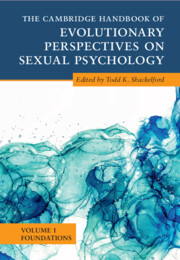Book contents
- The Cambridge Handbook of Evolutionary Perspectives on Sexual Psychology
- The Cambridge Handbook of Evolutionary Perspectives on Sexual Psychology
- Copyright page
- Contents
- Contributors
- Preface
- Part I Foundations of Evolution
- 1 Natural Selection
- 2 Sexual Selection
- 3 Inclusive Fitness Theory
- 4 Adaptive Problems in the Domain of Human Sexuality
- 5 Adaptations, By-products, and Spandrels
- 6 Evolved Psychological Mechanisms
- Part II Middle-Level Theories
- Index
- References
3 - Inclusive Fitness Theory
from Part I - Foundations of Evolution
Published online by Cambridge University Press: 30 June 2022
- The Cambridge Handbook of Evolutionary Perspectives on Sexual Psychology
- The Cambridge Handbook of Evolutionary Perspectives on Sexual Psychology
- Copyright page
- Contents
- Contributors
- Preface
- Part I Foundations of Evolution
- 1 Natural Selection
- 2 Sexual Selection
- 3 Inclusive Fitness Theory
- 4 Adaptive Problems in the Domain of Human Sexuality
- 5 Adaptations, By-products, and Spandrels
- 6 Evolved Psychological Mechanisms
- Part II Middle-Level Theories
- Index
- References
Summary
Inclusive fitness theory provides explanations for many cooperative behaviors – particularly among kin – that enhance one’s likelihood of reproductive fitness. In short, any allele responsible for cooperative social behaviors may be naturally selected if its possessor were able to reproduce more frequently than other members of the same species who do not possess that allele (i.e., those who possess a competing allele). Since the inception of inclusive fitness theory, evolutionary scientists have hypothesized various mechanisms and behaviors that could be the product of specific naturally selected genes. These mechanisms include kin recognition, kin selection, parental investment, parent–offspring conflict, sexual and emotional jealousy, and aggression. Inclusive fitness theory is also one of the most widely misunderstood theories in evolutionary psychology. In this chapter, we describe inclusive fitness theory and expand upon these mechanisms by reviewing various studies within the evolutionary psychological literature, while also addressing the key misunderstandings of inclusive fitness theory.
- Type
- Chapter
- Information
- Publisher: Cambridge University PressPrint publication year: 2022



